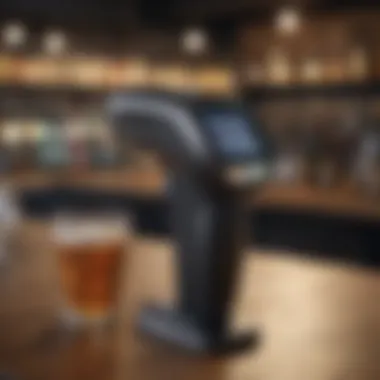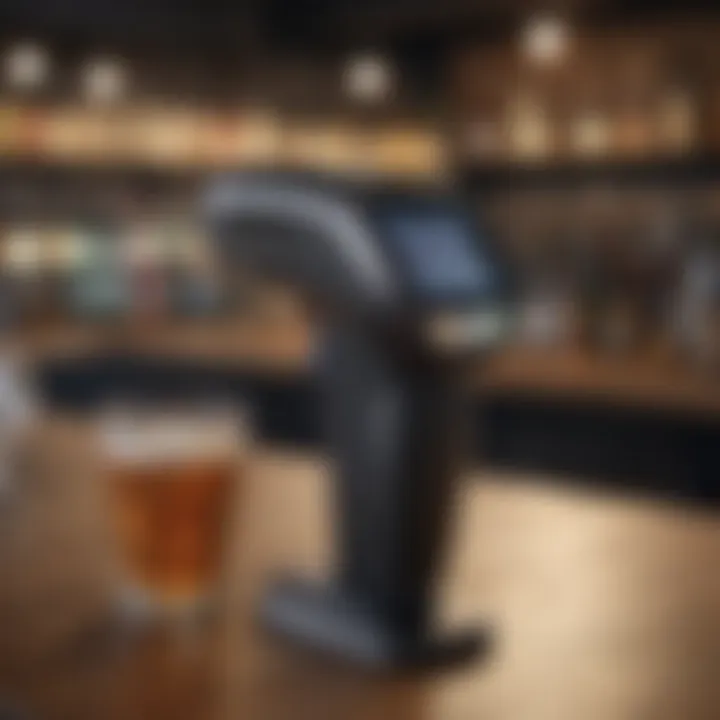Optimizing Operations with Bartender Barcode Scanners


Intro
In today's fast-paced business landscape, efficiency is not just a buzzword; it’s a necessity. For bars and restaurants, the minute a customer walks in, their experience needs to be seamless. As technology creeps deeper into everyday operations, bartender barcode scanners have emerged as a silvery bullet, offering solutions that address common pain points in the hospitality and retail sectors. These handheld devices not only help streamline operations but also enhance customer interaction, making them indispensable tools for modern businesses.
As we dive into the world of bartender barcode scanners, we will explore what sets them apart, how they contribute to improving business functions, and why they are increasingly essential for small to medium-sized enterprises. We will take stock of their key features, performance metrics, and the fluctuations in user experience that have developed over recent years.
By the end of this article, decision-makers will grasp the significance of integrating these scanners into their operations and the various ways it can boost productivity and improve service delivery.
Key Features of the Software
Understanding the core functionalities of bartender barcode scanners sheds light on their role in optimizing bar and retail operations.
Overview of Core Functionalities
One of the standout features of these scanners is their ability to instantly decode and verify barcodes. This is especially crucial during busy times when accuracy matters most. They often come equipped with:
- Real-time inventory tracking, which provides immediate updates when products are sold.
- Sales reporting options that allow managers to generate comprehensive sales data, aiding in data-driven decisions.
- Integration with point-of-sale systems that enhances the overall transaction process, making it faster and more reliable.
Furthermore, some systems also allow for mobile scanning capabilities, which enable staff to efficiently take stock without having to rely solely on fixed terminals.
Unique Selling Points
The unique selling points of bartender barcode scanners lie in their user-friendly interfaces and adaptability. Employees—especially in high-pressure environments—appreciate how quickly they can learn to use this technology. Unlike older systems that may require extensive training, most modern scanners come with intuitive designs that minimize user error.
Moreover, the versatility of barcode scanners means they are not just limited to one sector. They can be found in various environments including:
- Restaurants
- Retail stores
- Event venues
- Nightclubs and more
This adaptability makes them a prime choice for businesses looking for cost-effective solutions that provide excellent return on investment.
In-Depth Software Analysis
To make informed decisions about adopting barcode scanning solutions, it’s important to delve deeper into the pros and cons.
Pros and Cons
Pros:
- Increased operational efficiency allowing for quicker service.
- Enhanced accuracy in managing inventory, reducing errors during stock taking.
- Improved customer satisfaction as orders are processed swiftly.
Cons:
- Initial setup costs can be a hurdle for small businesses.
- Dependence on technology may pose challenges during outages or system failures.
Performance Metrics
Businesses can measure the effect of bartender barcode scanners through various performance metrics, such as:
- Reduction in order processing time: A tangible metric where service speed can be tracked pre- and post-scanner implementation.
- Inventory shrinkage decrease: Businesses might find that better inventory tracking leads to less waste and theft.
- Customer feedback: Direct reviews can capture whether patrons feel positively impacted by the improved service.
Preamble to Bartender Barcode Scanners
In today’s fast-paced business environment, streamlining operations is more crucial than ever. Bartender barcode scanners have emerged as a vital tool for businesses, particularly in the hospitality sector. They not only simplify processes but they also boost operational efficiency and enhance customer satisfaction. Understanding what these devices are and their historical journey sets the stage for their impact on modern business practices.
Definition and Overview
Bartender barcode scanners are devices designed to read and interpret printed barcodes, enabling businesses to track products, manage inventories, and process sales efficiently. Through optical scanning technology, these scanners translate the unique patterns of bars and spaces on a product's label into data that a computer or software application can easily read. This technology is pivotal for businesses that rely heavily on inventory management and speed, such as bars, restaurants, and retail shops. By automating the process of data entry, businesses can reduce human error and improve accuracy in tracking stock levels and sales activity.
"With bartender barcode scanners, the difference is clear—better accuracy, faster transactions, and a boost in customer satisfaction."
Historical Context
The origins of barcode technology can be traced back to the late 1940s when Norman Joseph Woodland and Bernard Silver created a system that used ultraviolet light to read information. However, it wasn't until the 1970s that barcodes began to gain prominence in commercial settings. The first barcode scanned at a retail point of sale was a pack of Wrigley’s chewing gum in 1974, marking a significant breakthrough in retail technology.
As technology evolved, so did barcode scanners, transitioning from bulky devices with limited functionality to sleek, sophisticated instruments integrated with advanced software. Today’s bartender barcode scanners not only read barcodes, but they also sync with complex inventory management systems, providing real-time data and insights. This evolution has been driven largely by consumer demand for speed and accuracy in service, which is why these scanners have become a staple in many modern businesses.
Given the fierce competition in the hospitality and retail sectors, understanding the historical context and mechanics of bartender barcode scanners is vital for any business looking to enhance operations and meet customer expectations.
Their continued evolution promises even greater functionalities in the future, making them indispensable tools for optimizing business efficiency.


How Bartender Barcode Scanners Work
Understanding how bartender barcode scanners work is crucial for businesses looking to harness technology for operational efficiency. These devices serve as the backbone of modern commerce, particularly in industries like hospitality and retail where speed and accuracy are paramount. By dissecting the various elements and their interactions, we can unravel the benefits and practical considerations that companies must keep in mind when implementing these systems.
Technical Components
When examining bartender barcode scanners, the technical components play a central role in their functionality. These scanners typically include:
- Optical Sensor: This is the eyes of the scanner. It decodes the printed barcode by capturing and interpreting the light reflected from its bars.
- Processor: Think of this as the brain of the device, where all calculations and interpretations happen. It takes the sensor's readings and turns them into data understandable by point-of-sale systems or inventory management software.
- Interface: This component facilitates communication. It can be USB, Bluetooth, or wireless connection, ensuring that the scanner can easily relay information to connected systems.
The synergy between these components is what enables real-time inventory tracking and transaction processing. But it’s not just the parts that matter; how they work together makes a significant impact on overall functionality.
Scanning Technology Explained
The technology behind barcode scanning has evolved significantly over time. Today's scanners often utilize either laser or image-based technology.
- Laser Scanners: These work using a laser beam that bounces off the barcode. They’re particularly good for reading traditional 1D barcodes, which are still widely used today. They offer quick and accurate reads, but can struggle with damaged or poorly printed barcodes.
- Image-based Scanners: Also known as camera-based scanners, these devices capture an image of the barcode and use software algorithms to interpret it. They excel at reading 2D barcodes, which are increasingly common, especially in the food and beverage sector.
Key Benefits of Scanning Technology:
- Speed: Efficient transaction processing.
- Accuracy: Reduced human error, excellent in high-volume environments.
- Versatility: Capable of reading various barcode types.
Integration with Software Systems
The integration of bartender barcode scanners with software systems is often what distinguishes a merely functional device from a powerful operational tool. The ability to link a scanner with various management systems allows for seamless data transfer. This setup aids in:
- Inventory Management Systems: Monitoring stock levels in real-time, automatically updating inventories as items are sold or received.
- POS Systems: Streamlining transactions by instantly inputting product details, which speeds up check-out times and enhances the customer experience.
- Reporting Tools: Facilitating easier tracking of sales data and trends, enabling better strategic decision-making.
A smooth integration process reduces operational headaches. However, it is vital for businesses to consider the compatibility of the chosen scanner with their current systems. Without proper integration, fallouts in data accuracy might occur, ultimately affecting customer satisfaction and financial health.
"The best barcode scanners breed excellence only when they can communicate efficiently with existing systems and align with business workflows."
In summary, the mechanics behind bartender barcode scanners are fundamental to their role in optimizing business operations. Each technical component, type of scanning technology employed, and the way these scanners integrate with software systems collectively determine their effectiveness. The ongoing technological advancements suggest an even brighter future for such tools, enhancing productivity and service delivery.
Applications in the Hospitality Sector
The hospitality sector stands at the forefront of innovation when it comes to employing technology to streamline operations. Bartender barcode scanners emerge as pivotal tools in this context, making processes smoother, faster, and more efficient. In the fast-paced world of restaurants, bars, and hotels, staying ahead of the competition demands a keen sense of organization and responsiveness, both of which can be significantly enhanced by utilizing these scanning solutions.
Inventory Management
An effective inventory management system is the backbone of any hospitality business. With the bustling environment of restaurants or the myriad of items in a hotel pantry, keeping track of stock can feel like searching for a needle in a haystack. Utilizing bartender barcode scanners allows for real-time tracking of inventory levels, making it much easier to identify when stock is low and what needs reordering. By scanning items as they arrive and updating records in one fell swoop, establishments can eliminate the guesswork.
- Reduced Waste: By maintaining precise control over inventory, businesses can minimize spoilage and wastage.
- Cost Savings: Identifying which items sell well and which do not aids in making informed purchasing decisions.
- Streamlined Ordering Processes: Barcode scanners can integrate with inventory management software to automate reorder alerts, ensuring that nothing runs out unexpectedly.
Transforming inventory management from a manual task into a streamlined process allows staff to focus on delivering exceptional service instead of dreading inventory audits.
Point of Sale Systems
When customers dine out or place orders, the point of sale (POS) system is where their experience takes shape. Bartender barcode scanners play a fundamental role in enhancing these systems. By simply scanning items on the menu, bartenders and waitstaff can instantly ring up orders with higher accuracy and fewer mistakes. This functionality is not just a convenience but a necessity, especially in bustling environments.
- Faster Transactions: Reducing the time spent on ringing up orders translates to faster service.
- Enhanced Accuracy: Mistakes in orders lead to customer dissatisfaction. Scanning items ensures that orders reflect exactly what the customer wants.
- Detailed Sales Reports: Integrated systems can generate insights on sales trends and customer preferences, further enabling businesses to tailor their offerings effectively.
These benefits culminate in a smoother customer experience, where long wait times and inaccuracies become relics of the past.
Customer Service Enhancements
In hospitality, customer service is king. The advent of bartender barcode scanners empowers staff to serve patrons more effectively and efficiently. Imagine a situation where a patron orders a drink that’s not on the menu. With a quick scan of a cocktail's components, a bartender can prepare something off-the-cuff without rummaging through shelves.
- Personalized Experiences: Scanners can provide staff with real-time information on customer preferences, allowing for tailored recommendations.
- Staff Empowerment: With more information at their fingertips, staff can answer queries or upscale menu items confidently, enhancing the overall experience.
- Loyalty Programs: Businesses can integrate loyalty rewards with barcode scanning technology, helping to recognize repeat customers and offer them personalized deals.
Bartender barcode scanners, thus, foster an environment wherein both patrons and staff can thrive, driven by reliable tech that underscores every interaction.
"In an era where convenience is crucial, the application of bartender barcode scanners solidifies operational success in hospitality."
By streamlining these diverse aspects of the hospitality sector, bartender barcode scanners serve not just as tools, but as essential components that elevate the industry as a whole.
Benefits of Using Barcode Scanners
In the fast-paced world of modern business, especially within the hospitality and retail sectors, the efficiency of operations can make or break an establishment. By harnessing the power of bartender barcode scanners, businesses can navigate the murky waters of inventory management and customer service with greater ease. This section covers the substantial benefits these devices provide, focusing on increased efficiency, cost-effectiveness, and improved accuracy, which are crucial in today’s competitive landscape.
Increased Efficiency


Time is money, or so the saying goes. Bartender barcode scanners streamline various processes, acting as a bridge connecting patrons with the goods they desire. Instead of manually inputting product data at points of sale or during inventory checks, these scanners dramatically cut down on the time taken for transactions and stock takes. This efficiency allows staff to focus their efforts on providing top-notch customer service rather than getting bogged down with tedious tasks.
Utilizing these scanners can transform the workflow in a bar or restaurant setting:
- Swift Transactions: Customers don’t have to wait in long lines. A quick scan can get them their drinks faster.
- Automated Inventory Counts: Barcode scanning simplifies counting and tracking of inventory, reducing the likelihood of human error.
- Overall Productivity: Staff can serve more customers in less time, effectively increasing sales.
Once the efficiency gains roll in, it’s like hitting the jackpot for businesses. According to studies, companies that adopt such technology often see a boost in both staff and customer satisfaction rates.
Cost-Effectiveness
Let’s face it, every business owner is looking for ways to cut costs while maximizing revenue. Bartender barcode scanners contribute to this through various avenues. Yes, there’s an upfront investment, but the return on that investment is significant, proving its worth over time.
Investing in a barcode scanner can lead to:
- Inventory Savings: Less overstock and waste. Knowing what’s on hand helps keep costs down.
- Reduced Labor Costs: Automation reduces the number of man-hours needed for basic tasks, meaning lower payroll expenses in the long run.
- Loss Prevention: Improved accuracy in scanning helps in minimizing theft and errors, further safeguarding profit margins.
Think of it this way: every penny saved on operations means more pies in the sky when it comes to profits. If a bar saves every month on inventory issues or labor needed for stock takes, that adds up considerably over time.
Improved Accuracy
In a bustling environment, even the slightest mistake can lead to significant consequences. Bartender barcode scanners greatly enhance accuracy in data entry, transactions, and inventory management. \n For example:
- Error Reduction: A barcode scanner eliminates the chance of human error often associated with manual entry methods. This is particularly vital during busy service hours.
- Real-Time Data: Scenarios where outdated or incorrect inventory figures could create chaos are greatly reduced since the data compiled is accurate and reflects real-time stock.
- Enhanced Reporting: Accurate sales and inventory reports allow businesses to make informed decisions regarding restocking and promotional strategies, leading to better overall management.
"Inaccurate inventory data is like sailing a ship without a compass; it leads to turbulent waters."
Moreover, consistent application of scanning leads to a reliable baseline of data over time. This reliability is invaluable for forecasting trends in both inventory needs and consumer preferences, enabling businesses to adapt quickly.
Challenges and Considerations
When thinking about integrating bartender barcode scanners into business operations, it’s critical to recognize the challenges and considerations that come with such decisions. While these devices can significantly enhance productivity and efficiency, understanding the potential hurdles can help businesses navigate their implementation more smoothly.
Initial Investment Costs
One of the prominent factors that businesses, especially small and medium-sized, must weigh is the initial investment costs of barcode scanners. The price of these scanning devices can vary widely. From basic handheld models to more sophisticated systems that integrate with existing software, the upfront costs can be daunting.
Consider a mid-sized restaurant looking to adopt a bartender barcode scanner system. Apart from the cost of the scanners themselves, which might range anywhere from a couple of hundred to several thousand dollars each, there’s also the necessity for any accompanying software. This can add up quickly.
In addition to purchasing the hardware and software, businesses must consider the costs pertaining to setup and installation. Custom configurations tailored to the specific needs of the operation can further inflate costs.
Training Needs for Staff
No sooner does a business invest in new technology, it must tackle another vital element: training needs for staff. Having the best tools is meaningless if staff are not equipped to use them effectively. Transitioning to bartender barcode scanners requires a learning curve, and not all employees might be tech-savvy.
The training can range from simple crash courses on how to scan and manage inventory to more complex sessions that cover troubleshooting and software integration. Typically, these training sessions require dedicating time away from busy shifts, which can intrude upon daily operations. Finding that balance can be a tightrope walk for many businesses.
It's essential to establish a clear training schedule and ensure that team members are comfortable with the equipment. Success here is vital, as proficient employees can turn barcode scanning from a potential frustration into a seamless part of the operational flow.
Maintenance and Technical Support
Lastly, businesses must think about the ongoing maintenance and technical support that comes with adopting barcode scanning technology. As with any technological solution, issues can arise, and systems may require updates or repairs.
Regular maintenance can ensure that the devices function correctly and the scanning efficiency remains high. However, scheduling downtime for maintenance can also pose challenges to business operations, especially during peak hours. Having a plan in place is essential.
Moreover, reliable technical support is crucial. Businesses need to ascertain whether the supplier offers robust support options, such as 24/7 assistance or training for troubleshooting common issues.
It’s crucial to choose a provider that supports not just the installation, but also the lifecycle of the technology.
The initial outlay for the technology, training staff, and providing maintenance and support can seem overwhelming, but understanding these challenges leads to well-informed decisions that can greatly benefit a business in the long run.
Future Trends in Barcode Scanning Technology
As businesses navigate through a rapidly changing landscape, staying ahead means embracing innovations. The realm of barcode scanning technology is no exception. Looking towards the future, there are distinct trends shaping how bartender barcode scanners can optimize operations across various sectors, particularly hospitality and retail.
Automation and AI Integration
One of the most prominent trends is the conjunction of automation and artificial intelligence within barcode scanning systems. Integrating AI not only streamlines processes but can also significantly enhance operational efficiency. For instance, imagine a system equipped with AI that learns from scanning patterns, predicting inventory needs before they become critical. This predictive functionality saves not just time but also reduces overstock scenarios dramatically.
- Data Analysis: AI can sift through vast datasets, providing insights that help businesses make informed decisions about purchasing and inventory management. The data extracted from barcode scans can inform managers of fast-selling products, helping in tailoring stock to meet consumer demand.
- Automated Stock Replenishment: With automation, the process of restocking can evolve from reactive to proactive. Systems could be put in place that triggers orders automatically based on real-time scans. This not only optimizes inventory levels but also ensures that customer demands are consistently met.
- Enhanced Customer Interaction: With AI monitoring customer behaviors via scans at POS, businesses can foster a more personalized shopping experience. Tailored marketing promotions can be generated based on scanning histories, driving customer engagement.
As companies consider integration, they must weigh these benefits against the required investment in technology and training. However, the value offered by these innovations often justifies the initial hurdles.


Mobile Scanning Solutions
The rise of mobile technology plays a pivotal role as well. Mobile scanning solutions are increasingly being favored, particularly within environments like bars and restaurants where speed is essential. Using smartphones or tablets equipped with scanning apps can significantly cut down on wait times.
- Flexibility and Accessibility: Mobile scanners allow staff to check inventory on-the-go. This mobility opens doors for staff to conduct inventory checks or serve customers without needing to be tethered to a fixed station.
- Improving Customer Service: Quick access to inventory and pricing information from mobile devices directly impacts the customer experience. Employees can provide prompt answers regarding product availability, further enhancing service levels.
- Integration with Loyalty Programs: Link mobile scanning apps to customer loyalty programs, where patrons can easily earn points while checking out, adding another layer of incentive for repeat business.
The transition to mobile solutions should consider compatibility with existing systems and the training required for staff to utilize these technologies effectively. Investing in mobile capabilities not only keeps businesses competitive but also elevates customer interactions to a more personalized level.
"Future innovations in barcode scanning will not only redefine operational efficiencies but will also transform customer experiences in ways we are just beginning to understand."
In summary, the future trends in barcode scanning technology, particularly regarding automation and mobile solutions, represent tremendous opportunities for enhancement in operational efficacy and customer relations. As businesses chart a course forward, incorporating these advancements can set them apart in a bustling marketplace.
Case Studies of Successful Implementation
The implementation of bartender barcode scanners in real-world scenarios serves as a testament to their efficacy in modern business operations. By examining specific case studies, it becomes evident how these devices contribute to enhanced efficiency, improved inventory control, and heightened customer satisfaction. This section sheds light on notable examples that demonstrate the tangible benefits brought about by the strategic integration of barcode scanning technology. By delving into real-life applications, readers can gain insight into practical considerations and potential pitfalls when considering such technologies in their businesses.
Hospitality Business Implementations
In the hospitality industry, where speed and precision are paramount, several businesses have adopted barcode scanners with remarkable results. Take, for instance, a mid-sized restaurant chain that struggled with inventory discrepancies and slow service. Prior to integrating bartender barcode scanners, restaurant staff would often spend hours checking stock levels and manually entering data into their point of sale systems. This process was not only time-consuming but also fraught with errors that impacted both inventory accuracy and customer satisfaction.
Upon implementing bartender barcode scanners, the restaurant reported the following benefits:
- Inventory Accuracy Improvement: By equipping staff with scanners, the restaurant drastically reduced inventory errors. Scanning items during both incoming shipments and daily service helped maintain real-time visibility of stock levels.
- Faster Service Times: The time taken to enter drink orders was cut significantly. Bartenders used to write down orders but could now scan directly into the point of sale. This sped up the process of order fulfillment, enhancing the overall customer experience.
- Enhanced Data Analytics: Improved data collection helped the management understand which items were popular and which were not, enabling better planning and menu adjustments.
Retail Sector Success Stories
In the retail sector, implementations of bartender barcode scanners have shown noteworthy success as well. A boutique liquor store facing the challenges of managing a wide range of products realized that its manual tracking system was falling short. Customers often experienced long wait times during checkout, and staff were overwhelmed during peak hours.
By implementing a barcode scanning system, the store achieved several key advantages:
- Streamlined Checkout Process: With handheld scanners, cashiers were able to quickly scan items, which substantially reduced wait times for customers. This not only improved customer satisfaction but also allowed the staff to handle more transactions per hour.
- Sales Tracking and Inventory Management: The scanners enabled immediate syncing of sales data with inventory systems, providing a clearer picture of product performance and stock levels, leading to a significant reduction in stockouts.
- Customer Engagement: With better inventory visibility, staff could offer informed recommendations based on what's in stock, enhancing personalized customer interaction.
The success seen by both the restaurant and liquor store highlights how valuable bartender barcode scanners can be in optimizing operations. Each case study showcases different contexts and challenges but points to a common outcome—enhanced efficiency and better customer experiences. Businesses in the hospitality and retail sectors, therefore, stand to gain considerably from intelligent implementations of this technology.
User Experience and Feedback
In the realm of bartender barcode scanners, user experience and feedback play a critical role in shaping how these systems are adopted and utilized in businesses. The way customers and staff interact with this technology directly influences not just the efficiency of operations, but also the overall satisfaction at the establishment. A smooth user experience can significantly enhance productivity and contribute to more positive outcomes.
Customer Satisfaction Rates
When customers walk into a bar or restaurant, they often have certain expectations; timely service and error-free transactions being two of the most common. Utilizing bartender barcode scanners allows for quick processing of orders, which can put a smile on the faces of patrons.
Consider this: when the time between ordering and receiving drinks is minimized, customers are likely to feel more valued and less frustrated. Research indicates that quicker service leads to higher satisfaction rates, making barcode scanners an asset.
- 75% of customers express they would return to a bar with quick service.
- A positive experience is often cited as a top reason for repeat visits.
The integration of barcode scanners can streamline the ordering process, reducing lines and wait times. Rapid service also often correlates with accurate order fulfillment, preventing those common "wrong drink" scenarios that can lead to dissatisfaction.
Staff Experiences and Challenges
On the flip side, staff experiences with barcode scanners can vary widely. While many employees appreciate the ease of use and the efficiency these devices bring, others may find the transition from traditional systems to more modern technology a bit daunting. A smooth implementation process, along with adequate training, is crucial.
However, challenges often arise when staff are not properly trained. For instance, employees might struggle with scanning issues, or they might find the software difficult to navigate, leading to frustration. Some common hurdles include:
- Learning Curve: New staff may feel overwhelmed with the need to learn a new system.
- Technical Glitches: Poorly functioning scanners can hinder operations, causing delays during peak hours.
- Support Availability: Access to technical support is vital. A lack of available assistance can leave staff feeling stranded.
Despite these challenges, when managed well, the feedback from staff can guide improvements and adjustments, ultimately enhancing their experiences with the system. Regularly collecting feedback through surveys or discussions ensures that issues are addressed, leading to a more harmonious working environment.
"Effective communication between team members about their experiences using technology is key to resolving challenges and improving overall operations."
End
In the fast-paced world of business, especially in hospitality and retail, the implementation of bartender barcode scanners has emerged as a game changer. These devices not only streamline operations, but they also address various pain points that businesses encounter daily. The importance of this topic lies in its multifaceted benefits, bridging efficiency with improved customer satisfaction.
Summary of Findings
Throughout this article, we explored several key elements regarding the role of barcode scanners in modern business operations. It’s clear that these devices serve a pivotal function in optimizing performance on both frontline and back-end processes.
- Efficiency Gains: With automation taking the guesswork out of inventory management and order processing, employees can dedicate their time to deliver exceptional service instead of manual tasks.
- Accuracy Improvements: Implementing these systems reduces the likelihood of human error, ensuring that orders are filled correctly, which directly ties into customer satisfaction.
- Cost Management: While there may be an initial investment, the long-term savings through reduced labor and minimized errors often outweigh these costs.
The successful integration of barcode scanners changes how businesses strategize and operate, paving the way for improved workflows.
Final Thoughts on Adoption
As we wrap up this examination of bartender barcode scanners, one cannot overlook the critical considerations for businesses contemplating adoption. The trajectory of operational success hinges on several factors:
- Assessment of Needs: It’s vital that businesses understand their unique challenges and how these devices could address them effectively.
- Employee Training: Ensuring staff are adequately trained is crucial. The technology is only as effective as the people using it, and insubstantial training can lead to poor implementation.
- Future-Proofing: Adapting technology that can evolve alongside business needs is an important aspect of any integration strategy. Mobile scanning solutions and AI integration point towards a future filled with potential enhancements.















